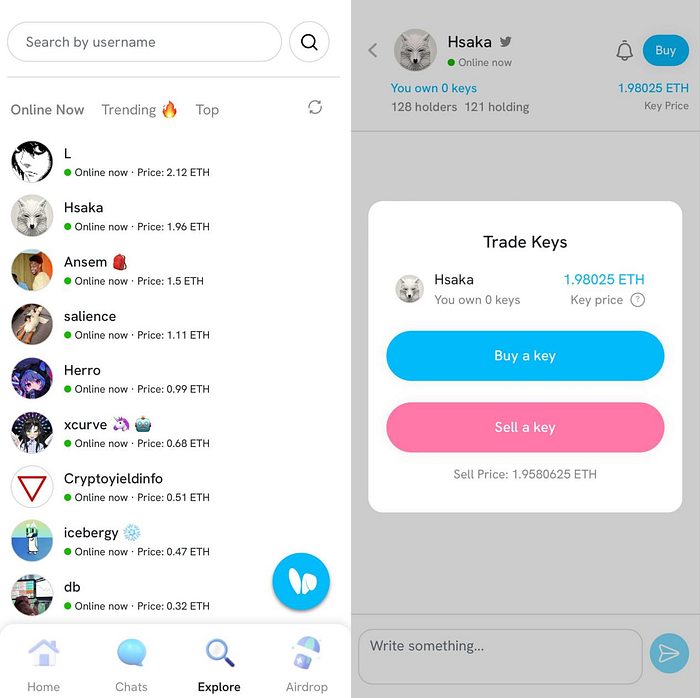After the Web3 social project friend.tech was launched on August 10, it caused a lot of discussion. After the KOL continued to share the invitation code, the influential KOL earned 80 ETH within 2 weeks of its launch.
In the past week, the transaction volume of friend.tech has continued to decline, and there has been little discussion and attention, especially in the Chinese encryption circle.
According to Dune data, in the 22 days since it went online, the cumulative number of transactions has reached about 2.48 million, and the cumulative number of protocol inflows into ETH has reached more than 50,000.
What is friend.tech?
Friendtech is an invitation-only Web3 social project built on the Base ecosystem that allows users to buy and sell “shares” connected to their Twitter accounts.
After the user registers with an email address and binds a Twitter account, a BASE account is automatically obtained. It is necessary to recharge 0.01ETH to the account to further explore on the friend.
Thanks to the promotion of friendtech, the current TVL in the BASE ecosystem has reached 292M, ranking 5th among all L2 ecosystems.
Users who own someone’s friend stake are allowed into private chat rooms that are shared with them and other stake holders. Friendtech has a strong bond with Twitter. The higher the KOL’s fans and popularity on Twitter, the higher the fan effect on Friendtech.
If you hold friendtech shares, you can also greet KOL and send private messages. Of course, whether the other party responds is another matter.
For example, if you want to say hello to Hsaka, who has 450,000 followers on Twitter, it will cost 1.96 ETH, more than $3,000; of course, he has also opened a private message on Twitter, and you can also private message him on Twitter for free.

How to play Friend.tech?
The essence of Friend.tech is to bet on the influence of KOLs, which is equivalent to issuing tokens for KOLs and monetizing the value of KOLs. It is an attempt to quantify social value.
But for ordinary web3 players or KOCs who don’t have much influence, Friend has no wealth effect and cannot bring direct benefits. Because no one is buying your shares, no buying, no trading, there is no profit.
Of course, if you joined Friend in the early stage and spent 0.01ETH to buy a certain KOL share, and as Friend continued to go out of the circle, the value of the KOL’s token increased, and the price of the token purchased with 0.01ETH increased, and you can also use it at a high price. Sell it at a good price, which means you have benefited from an investment that is optimistic about the development of a certain KOL.
But if you enter the market now and don’t know which KOL has a bright future, your investment will undoubtedly be in vain.

What is the value of Friend.tech?
As for the new socialfi method brought by friend.tech, some people are optimistic about it and some people are complaining about it, which is very controversial.
Those who like it think that friend.tech is a new attempt of socialfi, which allows the value and traffic of each KOL to be realized directly; KOL does not need to issue tokens and operations by itself, but only needs to continue to output content and value, and it can be done through friend.tech Realize and obtain direct benefits.
Opponents believe that socialfi should not have a threshold, it cannot be top-down, it is just a carnival of a few KOLs, it should be socialfi for the whole people, and ordinary users cannot participate in friend.tech interaction and gain benefits.
The current friend.tech invitation code system rejects many people, but only a small number of people play games. Moreover, friend.tech still has many bugs in data security and DAPP experience. Logging in through a third-party authorization may cause user privacy leakage and other issues. .
The biggest controversy lies in the fact that Friend violated the spirit of web3 encryption by collecting users’ twitter accounts and social relationship information, while the real beneficiaries are only well-known KOLs and early participants, as well as the platform itself.

Friend.tech has only been online for 3 weeks now, and it is not very popular anymore. I don’t know when it will be out of the circle again.
Just like the decentralized social Dumas that exploded out of the circle in the first half of the year, it has only been popular for two weeks; and Lens, which is not popular now, is not very popular, and web3 social networking really has a long way to go.
It is not easy to shake the status of web2 social networking. Every time Twitter pays wages to KOLs, it keeps the KOLs firmly on the platform.
What do you think web3 social networking is like?
The above is just my personal opinion, no investment advice. I am Chuxiaolian, and I am paying attention to the encryption market and web3.


